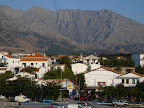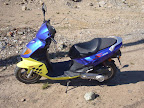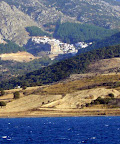Back on Samothraki:
Notes on the slide show are included below.
The pictures shown were taken in early September. The island is beautiful then. Most of the tourists have gone home and there's just a slight chill to the air in the mornings.
 Day two starts in Kamariotissa. The picture shows the main street of the little port town. At Mike's car and bike rentals you can rent a scooter, a motorcycle, a car, or sometimes even a house. I lucked out and got everything I needed in one stop!
Day two starts in Kamariotissa. The picture shows the main street of the little port town. At Mike's car and bike rentals you can rent a scooter, a motorcycle, a car, or sometimes even a house. I lucked out and got everything I needed in one stop!
There's a great internet cafe next to a coffee shop if you need to send messages home, or upload photos. The cafe is shown in the lower right-hand corner of this photo.
 This is all you need to get around to get around Samothraki! There's not a whole lot of traffic on the roads. Even on the rougher roads in the country, a scooter does just fine. Make sure you learn how to use the kick starter as well as the electronic ignition, the knowledge will come in handy. Also, keep in mind that the only gas station is located in Kamariotissa, so fill up before heading out.
This is all you need to get around to get around Samothraki! There's not a whole lot of traffic on the roads. Even on the rougher roads in the country, a scooter does just fine. Make sure you learn how to use the kick starter as well as the electronic ignition, the knowledge will come in handy. Also, keep in mind that the only gas station is located in Kamariotissa, so fill up before heading out.
 The first full day, I rode up to capital city of Χορασ. The ride is easy and only takes about thirty minutes. The city is nestled into the hills of the island. It can actually be seen from the ferry on the ride to Samothraki. The remaining slide show photos are of Χορασ.
The first full day, I rode up to capital city of Χορασ. The ride is easy and only takes about thirty minutes. The city is nestled into the hills of the island. It can actually be seen from the ferry on the ride to Samothraki. The remaining slide show photos are of Χορασ.
The Locations:
View Larger Map
Do you have notes about Samothraki? Please add them to the comments below.
Notes on the slide show are included below.
The pictures shown were taken in early September. The island is beautiful then. Most of the tourists have gone home and there's just a slight chill to the air in the mornings.
There's a great internet cafe next to a coffee shop if you need to send messages home, or upload photos. The cafe is shown in the lower right-hand corner of this photo.
The Locations:
View Larger Map
Do you have notes about Samothraki? Please add them to the comments below.